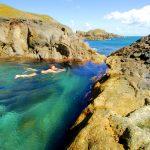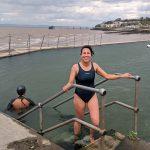
Interview: Adam Knight – Zoggs Learn to Swim Ambassador
Swimming teacher Adam Knight recently signed up with swimming brand Zoggs as their Learn to Swim Ambassador. Adam is an STA level 3 Swim Tutor and a Level 2 Baby Swimming Specialist. He is the founder of Angel Swim London and has been teaching children to swim for 10 years. He’s also an Ironman finisher and in 2022 is aiming to complete an English Channel relay to raise funds for SwimTayka. He teaches swimming to people from 4 weeks to 86 years old.
We caught up with Adam to ask him about learning to swim and safety around open water and collected his top tips for parents of potential outdoor swimmers.
As an outdoor swimmer yourself, have you ever considered running learning to swim courses in open water? How would you go about doing this?
Yes, I have considered running learn to swim courses in open water. However, there are many barriers to overcome when first learning to swim – fear, lack of coordination and poor technique.
As a teacher you want to limit the number of hurdles for your learners. Open water in the UK offers additional challenges such as colder temperatures, reduced visibility, currents, tides, wildlife and weather compared to indoor swimming pools. Therefore I would recommend that learn to swim ideally occurs in a pool as there are fewer variables to contend with.
For those that do not have the luxury of access to an indoor pool I would run a learn to swim programme in open water by completing the following:
- Risk assess everything.
- Ensure that staff are professionally trained and experienced in rescue, CPR and first aid.
- I would research the tides, currents, depth, weather and emergency services a week before, a day before and again on the day so we are prepared for any emergency situation.
- If swimming in the ocean, I would do so in a shallow area where swimmers can touch the floor with a lifeguard present. I would also mark out a boundary with floating ropes and buoys.
- To combat the cold I would make long wetsuits, swim hats and goggles mandatory and keep swimmers active and moving at all times.
- Smaller classes – in an ideal world a 1:1 teacher to student ratio would be the safest and best for progress with the instructor teaching IN water.
At Angel Swim London, when my students can consistently swim 100m or more in a pool environment that is when I would introduce them to open water. Introducing swimmers to open water at a more advanced stage minimises the risk of having a negative experience and maximises the chances for success in my opinion.
What advice do you have for parents of pre-teens who’d like their children to experience the joys of outdoor swimming?
Educate, Insulate and Inspire!
Educate your children on all the risks and skills involved in open water swimming.
If your children understand the risks of cold water shock, hypothermia, tides and currents they will be significantly less likely to fall victim to them. Open water swimming also requires specific skills such as sighting, buoy turns and swimming in a wetsuit – having the right kit is why I have partnered up with Zoggs. I would highly recommend hiring a qualified STA Open Water Swim coach to do this.
Insulate your children
No one likes being cold! If you want your children to have fun and enjoy open water swimming ensure they stay warm by getting them a long wetsuit, swim hat and goggles. Zoggs Predator goggles are unrivalled for open water swimming in my opinion.
Inspire your children
Open water swimming can lead people to achieve incredible things. My mentor, Keri-anne Payne is a two-time marathon swimming world champion – tell your children her story and they could be inspired to do the same. Ross Edgeley swam around the whole of Great Britain – tell your children his story and they could be inspired to do the same. Alice Dearing was the first black woman to represent GB at the Open Water Marathon Swim at the Tokyo Olympic Games 2020 – tell your children her story and they could be inspired to do the same.
What advice do you have for teenagers and parents of teenagers to ensure they stay safe around open water and can keep their friends safe, especially when they see people engaging in risky activities such as jumping from bridges and swimming near weirs?
My advice for teenagers and parents of teenagers in regards to staying safe around open water is the following:
Follow the signs – if there is a sign saying “no swimming” near a weir make sure you follow it or risk losing your life. What might look like a fun waterfall has deadly undercurrents that will pin down and drown even the strongest swimmer. Don’t let peer pressure or a friend lead you to your death.
Do not Jump – Jumping from a height into open water or “tombstoning” has killed 20 people and injured hundreds more at Durdle Door in Dorset since 2005. This is due to submerged rocks, tides changing so water being shallower than it seems and strong currents and rips pulling swimmers out to sea.
Be seen and never swim alone – If you swim in open water make sure you swim where there is a lifeguard present, wear a tow float and always swim with at least one other person so that if either of you gets into trouble, the other can call for help.
What training and preparation are you doing for your upcoming English Channel relay – and do you think it will be easier and harder than an ironman?
In August 2022 I will be swimming the English Channel as part of a relay team for an incredible charity called SwimTayka. They send volunteer swim teachers to help children in Mozambique, Indonesia, Jamaica, Brazil and Peru.
For my preparation I am swimming five times a week, three being speed or threshold sessions so that if the tides are strong I will have some gas in the tank to keep on steaming forwards. The other two sessions are low intensity, longer distance swims of around five kilometres to build base endurance and fitness. I am also building up my tolerance to cold water exposure by taking cold showers and slowly letting go of my beloved wetsuit as I acclimatise to the cold.
Will it be harder than an Ironman? An Ironman requires you to perform three different sports over an average time of 13 hours continuously. It requires great stamina and incredible mental fortitude to keep going. The 3.8 kilometre swim takes around 1.5 hours of the 13 hours and is done in a wetsuit which provides warmth and a bit of extra buoyancy.
The Channel relay swim will involve two or three hours of swimming. However, this will be done in just a pair of trunks in cold water, with strong tides, there will be jellyfish and potential seasickness from being on the boat and part of the swim will be done at night. There is also the added responsibility of looking out for your team, which is a role I take very seriously as it needs all six of us working together to get to France.
Each challenge poses its own unique set of obstacles, which makes them hard to compare. All I know is that I want to be as fit and prepared as possible so that I can deliver on the day.








